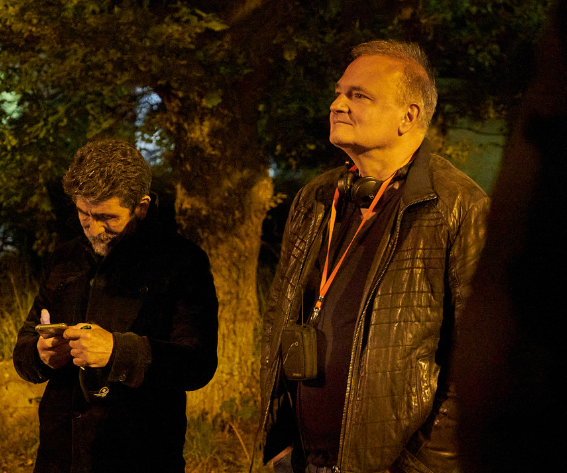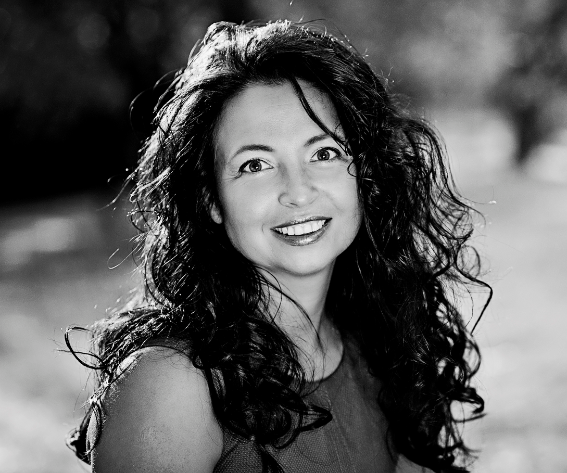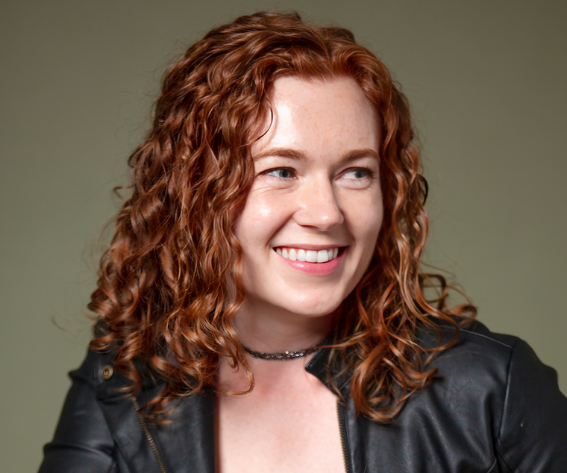Our August 2020 big winner was The Widow: a film about Sicilians, taking place in Australia, back in the 1960s. We discussed the project with its director, Brendan Young.
JL: Congrats, Brendan, for all the awards! There was some tough competition this month, but in the end, your film came out on top.
Brendan: It was an absolute thrill to be a part of The Monthly Film Festival. We were all completely blown away and humbled by our awards. And we were well aware of the incredibly line up of quality international films in this particular month’s competition.
JL: Most movies about Sicilian mobs are set in New York. Melbourne was such a refreshing setting for the genre – why did you choose it as the location?
Brendan: In terms of Melbourne as a setting, it’s based on historical fact. As the opening pre-title card in the film suggests: “some of this story is true”. But I think it’s important to clarify that the “The Widow“ is set among the Calabrian immigrant community here in Melbourne, Australia. The lead character Luisa is Sicilian and that was intended to create a nuanced distinction to underscore her status as an “outsider” or “the other” in a strictly Southern Italian regional immigrant hierarchy. So, this aspect does set it apart from your standard Hollywood/ New York mafia crime film, which often feature Sicilian born characters. And that was based on a simple historical fact: the mass of migration from Sicily to the United States, particularly New York, at the turn of the last century onwards. Whereas in Australia, mass Southern Italian migration occurred in the aftermath of World War II, with a major influx in the 1950s and a predominance of Calabrian born immigrants. It emerged that acolytes of the long-established Calabrian criminal entity, the ‘Ndrangheta, were among the many thousands of migrants arriving in Melbourne. However, there is evidence of ‘Ndrangheta gang culture was present here in Melbourne as far back as the 1930s as Calabrian criminals fled Mussolini’s fascist law and order crack down in the South of Italy. Ultimately, these immigrant criminal cells amalgamated and blossomed as they turned inward, threatening and extorting people in their own migrant communities. The most notorious of these criminal entities was known as “L’onorata societa” (The Honoured Society) I grew up in Melbourne and lived in an inner-city suburb which was mainly a migrant enclave. My closest friends were from Calabrian and Sicilian migrant families and I was well aware of the sensational stories concerning local criminal activity particularly centred around the produce industry.
JL: And any particular reason for the 60s setting?
Brendan: As I previously mentioned, “The Widow” is based on a series of real life events, which occurred in Melbourne between late 1963 to the mid 1960s. A spate of violent murders and assassinations gripped the city, as members of The Honoured Society, engaged in a bloody, internal power struggle to determine who would seize control of the organisation in the wake of the natural death of their long reigning mob boss. The period, by pure coincidence, reflects my love of European, particularly French and Italian new wave cinema of the early to mid 1960s. I saw a fabulous opportunity to marry the stylistic tropes of the Nouvelle Vague with a genuine time-relevant historical setting. Although to be honest, once that idea was embraced, I started to explore my own stylistic interests. But there are key elements expressed in the look, feel and mood of the film which hark back to that particular 60’s Euro cinema.
JL: What came first when writing the script: the setting, the location, the plot, the main character, or something else?
Brendan: I’d always wanted to make a gripping and evocative Australian-set crime film but wanted to take a very different approach to the usual Oz crime film and tv milieu. The lead character Luisa Benvenuto was definitely the main starting point. We’re so used to seeing mob stories and crime thrillers featuring the usual suspects of machismo, tough-talking violent male characters. While this is a very real and aspect of criminal cultures everywhere, I was intrigued to explore the narrative through a distinctly feminine perspective. And I had an evocative precedent. Luisa was based on a real-life person; a Calabrian woman who lived at the end of my street when I was a young boy. She was an elegant, rather austere widow. And according to salacious stories told to me by my parents, her husband was gunned down at the Queen Victoria fruit and vegetable markets as part of that notorious gang war, years previously. My father was a real estate agent at the time and he brokered the sale of her house when she eventually decided to sell up and move on in the wake of her husband’s death. The eager and naive Anglo-Australian real estate agent character featured in my short film is very loosely based on my father. So, the genesis of the film really was: “so what actually happened to the widow who lived down the end of my street?”. In my wild, fictional re-telling, I imagined an intense, doomed, romantic involvement – echoing my other great cinematic love – classic Film Noir – that mingled with the real-life events of the ‘Ndrangheta gang war from 1964. A kind of violent love story that goes terribly wrong. In the end, I was fascinated in the emotionality of the idea rather than the criminality. That said, I did make sure there was enough gritty and physical action to keep it well within the genre mould.
JL: What was the most difficult aspect of making The Widow?
Brendan: The very low and ludicrously tight budget was quite a challenge. Particularly for a period film! We’d raised our production budget through a local crowd-funding platform and contributing some of our own money. Thankfully, I’m not a filmmaking ingénue and the years of previous experience did pay off with a project so ambitious and constrained as this. Preparation is everything. I spent ages tracking down appropriate locations that could be dressed or used to recreate the time period effectively. We had limited funds to hire and dress locations, so there had to be certain inherent period aspects in a location to convincingly convey the setting. Shooting in black and white helps enormously, of course. The budget also meant we had to engage a crew which was a mix of very experienced department heads and newcomers just starting out. Having said all that, the extremely tight budget threw up all sorts of intriguing challenges which resulted in a number of inventive approaches and solutions. A lot them held together with literal “sticky tape and glue” as we say down here. And while the film is understandably a little roughly hewn in places, strangely, the constraints contributed positively to the overall aesthetic that I’d always intended.
JL: You wrote the project, directed it, and also did the editing yourself! That’s a lot of excellent work, Brendan! Do you enjoy any of these more than the others?
Brendan: Being on set, the actual physical process of filmmaking, is something I love and live for. It’s a thrilling experience every time you go out to try and actualise and capture a narrative, a performance, a moment, a set-piece. Even though I’ve worked professionally as a cinematographer off and on over the years, directing has always been my pure joy. Ironically, I never intended to edit the film. I have long experienced the fruits of working with incredibly talented film editors. And clearly, just having someone in an objective role seeing the footage fresh and released from all the irrelevant day to day dramas of shooting and on-set minutiae allows for a clear and concise evaluation of the material. As it happened often with this project, some talented and very experienced crew members had to drop out at the last minute due to lucrative offers of work or unworkable schedules etc. I’d lost my long-term editor to a decent paying gig. However, she was very supportive and encouraged me to step into the role. I wasn’t a complete novice. I’ve been editing films and videos in some form for quite a while, starting way back when I was a kid cutting my goofy home-made films on a hand-wound Super 8 film editor! At first it seemed a little daunting. But I really got heavily invested in the process. All along challenging myself to try and be as objective as possible. It was a thoroughly positive experience. I learnt so much and I’m very happy with the end result, give or take a few minor moments. Still, I can’t wait to work with established and talented editors again!
JL: Daniela Farinacci was the heart and soul of the film, and deservedly picked up the Best Actress award. How was it like to work with her?
Brendan: You are so right to describe her as the “heart and soul”. The film literally couldn’t exist without her. They often say, 70% of directing (or is it another figure?) is “in the casting”. In Daniela’s case it couldn’t be more strikingly clear. Working with her can only be described as a blissful creative experience. I had known of Daniela’s work in the Australian film and tv industry for many years. She made an impressive debut as a young actor in Ray Lawrence’s multi-layered thriller, “Lantana” way back in 2001. I immediately noted she was an actor to watch and someone I definitely wanted to work with at some point. “The Widow” threw up a number of casting challenges. Not only did I need to cast a talented Italian speaking “mature-age” actress, but I had to find someone who could convincingly speak in a local Sicilian dialect which was key to the authenticity of the role. Let alone all the physical, low budget rough and tumble. There was no money for stunt doubles or even a decent stunt coordinator. But Daniela was beyond brilliant. She’s an incredible blend of the highly focused and driven researcher with the purely emotional, instinctive and nuanced performer. She spends an enormous amount of time in preparation for a role – no matter how big or small. And she’s intensely dedicated to making the character as vivid and captivating as possible. The use of language in “The Widow” is an important aspect of the film. We engaged two translators to work on the script helping to craft the dialogue into a genuine recreation of the type of patois spoken by Calabrian and Sicilian migrants in Melbourne at the time. Both the translators had grown up in Melbourne in the late 1950s and 1960s so they had a lived experience of the way the community spoke. Although, it’s an intriguing cultural point, perhaps lost on a lot of non-Italian viewers of the film, but Luisa speaks mostly in Sicilian dialect while the rest of cast speak Calabrian. This reflects the way people from different regional Southern Italian migrant communities communicated back then. They rarely spoke standard Italian. Daniela, who has Italian heritage and can speak and understand reasonable Italian, had never spoken Sicilian dialect before in her life, dived into mastering the dialect. According to old folks from the Sicilian-Australian community here in Melbourne who attended our cast and crew screenings – she nailed it! One of her many talents is pushing herself to embrace the technical necessities of a role and then allowing it to become a natural expression of her performance. By the time we came to shoot, with a tough shooting schedule, there was very little time to discuss the technicalities of the role on set. We had developed a concise short hand and a complete trust. There was very little to say except provide a safe and comfortable space for her to let he do her stuff. And as you can see, she’s absolutely terrific as Luisa.
JL: Was the project finished pre-corona, or did any of the post-production work take place during the pandemic?
Brendan: Luckily for us the film was shot and post produced before the pandemic. To be honest, it would have been impossible to make a film like “The Widow” with all its indoor and outdoor locations particularly here in Melbourne where we’ve had varying degrees of strict lockdowns from late March until now, being October.
JL: And speaking of corona, did you manage to get some work done on other projects during the lockdown? Writing a screenplay, perhaps?
Brendan: Yes indeed. Here in Melbourne, unlike most of other parts of Australia, we’ve been in lockdown for many months! I’ve spent most of the time working on developing “The Widow” as a 6-part limited drama series for streaming. I’m busy writing up all the episodes for the pitch and my aim is to use the short film as a “proof concept” to help kick the series version into a reality. The expanded narrative is allowing me to include sequences that would’ve never been possible in the short film – including Luisa’s tragic and violent backstory in a Sicilian village as a young woman which ultimately leads to her emigrating to Australia. The aim is to try and mount the project as an Italian-Australian co-production. I also managed to shoot and direct two music videos during the lockdown – having to be inventive and resourceful as there was major restrictions on movement and outdoor activity. And basically, you couldn’t interact with other people from “different households”. One music video was in fact directly inspired by “The Widow”. British band CousteauX had seen the trailer for the film on-line somewhere and they reached out and contacted us. They presented us with a beautiful and evocative song called” When The Bloom Has Left The Rose”. The general direction was – “Can you do something in the vein of The Widow?! “It turns out the band was incredibly taken by Daniela’s performance in the film. It was Daniela’s incarnation of Luisa, and the overall look and style of “The Widow” that led to them approaching us. So, with little budget, and being on the other side of the world from the band, my partner in life and crime (the co-producer, composer and costume designer of “The Widow”) Catherine McQuade and I, made another period setting narrative music video. This time set somewhere in the North of England in the early 1960s – a style reference to classic British Kitchen sink dramas. Because of the lockdown restrictions I couldn’t approach Daniela or any other actors for that matter to play the central role in the video. Again, being resourceful as we could, Catherine stepped into the role of an ageing cabaret singer who comes to grip with some emotionally devastating moments in her life backstage in her dressing room in a local, run down theatre. I stepped in to play (thankfully only as a fleeting silhouette!) a callous lover in a series of flashback moments. We managed to shoot the entire video in and around the old factory complex where we lived and occasionally snuck into the city centre to shoot some sequences on a few early mornings, avoiding the police! We’ve started entering the music video into film festivals and already we ‘ve collected a number of awards, including a “Best Debut Performance“ award for Catherine from the Vegas Movie Awards in the US just last week. The bottom line is – regardless of the pandemic, creative folks have got to keep creating!
JL: Thanks for your time Brendan! Stay healthy and do submit your next projects at TMFF, we’d love to see more!









Leave a reply